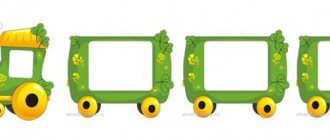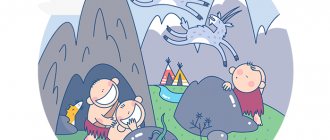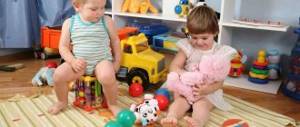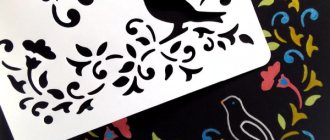Do-it-yourself non-standard manuals for sensory development of children 2-3 years old
Non-standard aids for the sensory development of young children.
Author of the work: Zulfiya Damirovna Sanieva, teacher at the Solnyshko kindergarten, Yangelskoye village, Republic of Bashkortostan. Description of work
: non-standard toys and aids made from waste material for the sensory development of young children. The material will be of interest to educators working with children and parents. I would like to bring to your attention toys and manuals made by myself for young children. As is known, during this age period the main activity of children is object-manipulative actions, and sensory experience, as we know, is the source of knowledge of the world. Working with young children, I set myself the following tasks: - improve perception, the ability of children to actively use touch, vision, hearing; - to form children’s ideas about color, shape, size; — to develop children’s interests in didactic games, independence and focus in objective activities. Along with specially selected toys and aids that are available in the didactic corner, I also made non-standard toys that interested the children to a large extent.
"OCTOPUSY-NOISE-MAKER"
The octopus is made from Kinder Surprise capsules, tied with threads in rainbow colors, and the capsules contain fillers that sound different in all the “tentacles.” The game helps to consolidate primary colors, develop auditory perception and differentiate different sounds.
"COLLECT BEADS"
The beads are made from the caps and bodies of empty markers. Children string them on multi-colored laces, fixing the colors, training fine motor skills, and while playing they develop perseverance and determination.
"SOFT PYRAMID"
The parts of the pyramid are made of fleece fabric, they contain fillers (balls of various materials, coins, polyethylene granules from rattles, rustling foil and paper, cotton wool, etc.), and are attached to each other using Velcro. The pyramid promotes the development of fine motor skills, color perception, tactile sensations, and the consolidation of the concepts of “more” and “less”.
"LET'S FEED THE BIRDS"
The goal of the game is to feed the colorful chicks with “grains” of the same color. The game is designed to introduce and reinforce primary colors. Plastic bottles decorated with colored self-adhesive paper and appliqué “acted” as chicks, and “seeds” could be bottle caps, or in our case, mosaic chips.
"MONEY BOX"
This game is especially loved by my kids, because at this age they love to play with small objects that can be collected, poured out, sorted, etc. Here we use a bucket with a lid with slots for plastic caps from injection bottles. Naturally, everything was washed, disinfected, and processed in advance. Adult supervision is required during play. The game develops fine motor skills, the ability to act purposefully, and trains the eye.
“PICK THE LID TO THE JAR”
Vitamin jars of different sizes were used and covered with multi-colored self-adhesive paper. Children learn to unscrew and tighten lids, selecting them by color and size; here they also reinforce color and concepts of size, and train fine motor skills. To organize games at home, you can drop a little essential oils - fir, lemon, vanilla and others - into jars - this will simultaneously benefit your health and train you to develop your sense of smell.
"HOUSE FOR MOSAIC"
The game was invented after the final “death” of the floor mosaic box, and it was necessary to find a way to store multi-colored chips. I spotted the idea in some magazine, but it was improved by me in the process of making the “house”. I covered the shoe box with self-adhesive tape, cut out partitions from the remains of PVC panels, and attached them with double-sided tape to the bottom and walls of the box. I divided the lid into four multi-colored sectors and cut out windows according to the size and shape of the chips. Children match chips by color and place them in the corresponding “rooms”. When we open the lid, we can see whether we have placed the “tenants” correctly and “who ended up in the wrong house.” During the game, we also strengthen the recognition and discrimination of primary colors, coordination of movements of the fingers and hands. Dear educators, I will be glad if the ideas I proposed will be useful to you in equipping a subject-development environment. Thank you for your attention!
We recommend watching:
Didactic game for preschoolers to develop fine motor skills Do-it-yourself didactic manual for kindergarten Do-it-yourself book from a candy box. Master class with photo Do-it-yourself didactic game for kindergarten
Similar articles:
Do-it-yourself didactic games made from waste material
Do-it-yourself didactic game for preschoolers “In the world of animals”
Do-it-yourself didactic game for kindergarten on the topic “Sports”
Didactic game for children 2-3 years old “Wash the doll”
Didactic game for children 2-3 years old. Bathing a doll
Organization and structure of didactic games in an early age group
Organization of the game includes:
- preparation for the event;
- direct gaming activity;
- analysis.
When preparing the game, the teacher must:
- select it, guided by the set goals and objectives;
- choose a convenient place and time (during organized educational activities, walks, morning reception) for the game;
- determine the number of participants;
- prepare material, equipment;
- think about the course of the game, methods of managing it (showing, explaining);
- carry out preliminary work with children.
Timing game plan
The didactic game goes through the following stages:
- Introductory part (1–2 min). Children are briefed on the content of the game and shown the didactic material that will be used in it.
- Main part (6–7 min). Message of the game task and rules of the game. For the little ones, the rules are extremely simple, and their explanation does not take much time. If not all children understood the rules immediately, the teacher explains them again as the actions are performed.
- Show game actions. It should be clear, understandable, and can be repeated during the game.
- Performing play actions by children under the direct control and participation of a teacher, who not only seeks interaction between the child and an adult, but also directs children to interact with peers.
A didactic game in a group of children of the third year of life can last on average 8–10 minutes, but this framework is not strictly limited. If children's interest in the game is great, then it is extended, developed, and it can last up to 15 minutes. Having noticed that the children are tired and distracted, the teacher has the right to end the game earlier.
After the game, the teacher analyzes its progress and results: what worked, what didn’t work, what techniques turned out to be the most effective and helped achieve the goals. Children's individual preferences in the game should also be noted and taken into account in subsequent games.
Analysis of the game helps the teacher modify it in the future, enrich it with new material.
Table: example of a summary of a didactic game in the first junior group
| Author | Shevtsova E.A. |
| Name | "Funny Bugs" |
| Game objectives |
|
| Materials | Images of a black beetle, a sun beetle, circles and squares in black and red, musical accompaniment. |
| Introductory part | The teacher draws the children's attention to a large black beetle (image) on the rug. Tell us, black beetle, why it suddenly came to us. The beetle moves its mustache and says to the kids: I’m a little bored, I’ve lost my kids. Could you guys find my children? And then you and I together will have fun playing. V.: Let's look for where the black beetle babies are hidden. |
| Main part | Q: Guys, what color is our beetle? (Black). What shape is it? (Round). This means that his children are black and round. Let's see if they are here on the lawn. A “lawn” (green cloth or paper) is placed on the table, and on top of it are geometric shapes, circles and squares in black and red. Children choose black circles. Q: Why did you decide that these were the babies of our beetle? (They are round and black). Let's take the kids to the big bug. How many big beetles? (One). What about the little ones? (A lot of). What color are the beetles? (Black). And now the bugs want to have fun with us. Music sounds, children perform voluntary movements, holding beetles in their hands. V.: Well, we played with the bugs. Now let’s put them on the grass and let them rest next to the big beetle. (Children lay out circles on a green background). While we were dancing, another beetle flew towards us. (The teacher puts a picture of a ladybug on the easel). What colour is he? (Red). Let's find his kids too. Children are looking for red circles. V.: Oh, how happy the bugs were and wanted to fly high, high. And then they sank down, flying low, near the ground. And high again! (Children repeat the movements with the bugs after the teacher). Let's put the bugs near their mother, they miss her. And then we'll play with our bugs some more. |
| Final part | Q: Guys, who came to visit us? What color were the beetles? Were they square or round? Have you found any baby beetles? (Children's answers). Yes, you did it, well done! |






